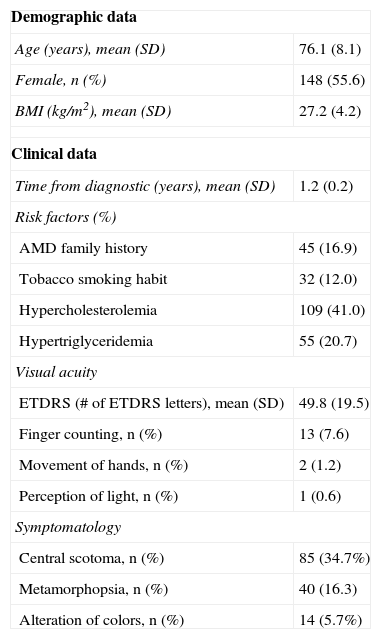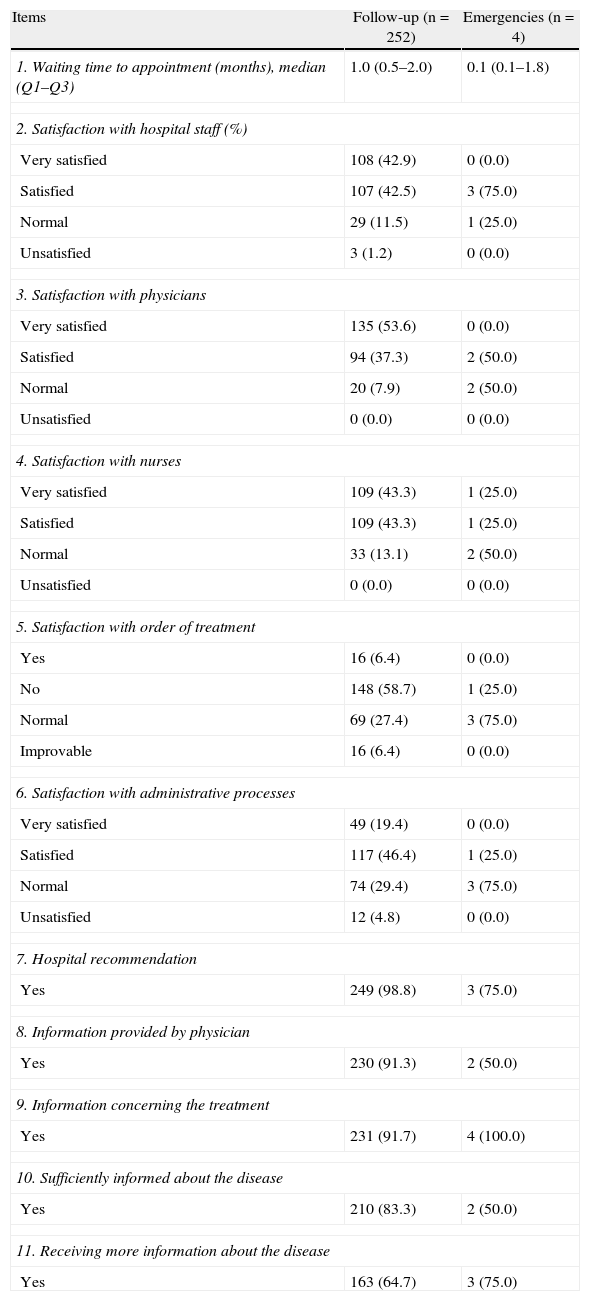The aim of the study was to assess the availability of resources for patients with wet age-related macular degeneration (wAMD) in current clinical practice.
MethodsObservational, cross-sectional and multicenter study. Eligible subjects were ≥18 years old, with primary/secondary active subfoveal AMD-related choroidal neovascularization diagnosed 12–18 months prior to inclusion in the study.
ResultsA total of 266 patients were included (39 centers). The mean age (SD) was 76.1 (8.1) years, of whom 55.6% were female. According to the investigator assessment a median (Q1–Q3) of 20.0 (10.0–50.0) patients were visited weekly. A mean of 100.0 (45.0–250.0) were currently under treatment mainly performed in operating rooms (61.5%). Centers had 1.0 (1.0–2.0) operating rooms available for treatment 2.0 (2.0–5.0)days/week. In 74.4% they were located on different floors/buildings from ophthalmology services. Waiting time until visit was 40.0 (30.0–60.0)min, and duration of treatment was 20.0 (15.0–50.0)min. The time between request until medical visit was 20.0 (15.0–30.0) days, and from diagnosis to treatment was 7.0 (5.0–10.0) days. Clinicians considered that there were insufficient staff for examinations (84.6%), and treatment (46.2%). About 30.8% and 20.5% mentioned lack of diagnostic tools, such as optical coherence tomography and fluorescein angiography.
ConclusionsMore resources for diagnosis and treatment of wAMD are required. These results, together with the current policy of reducing the budget in the Spanish Health System, could lead to possible delays in the diagnosis and treatment of wAMD.
Evaluar la disponibilidad de recursos para los pacientes con degeneración macular asociada a la edad de tipo húmedo (DMAE-h) en la práctica clínica actual.
MétodosEstudio observacional, transversal y multicéntrico. Se incluyeron pacientes ≥18 años, con neovascularización coroidea activa principal/recurrente secundaria a DMAE-h, diagnosticados desde los 12-18 meses previos al inicio del estudio.
ResultadosParticiparon 266 pacientes (39 centros). La media de edad (DE) fue de 76,1 (8,1) años, siendo 55,6% mujeres. Según valoración de los investigadores se visitaban semanalmente de mediana (Q1-Q3) 20 (10,0-50,0) pacientes con DMAE-h. Actualmente, 100,0 (45,0-250,0) estaban en tratamiento realizado mayoritariamente en quirófanos (61,5%). Los centros tenían 1,0 (1,0-2,0) quirófano disponible para el tratamiento, durante 2,0 (2,0-5,0) días/semana. El 74,4% estaban en plantas/edificios diferentes de la consulta oftalmológica. El tiempo medio de espera para la consulta fue de 40,0 (30,0-60,0) min y la duración de la administración del tratamiento 20,0 (15,0-50,0) min. El tiempo medio entre solicitud y visita médica fue de 20,0 (15,0-30,0) días y desde el diagnóstico hasta el tratamiento 7,0 (5,0-10,0) días. Los investigadores consideraron insuficiente el personal para exploraciones (84,6%) y tratamiento (46,2%). Un 30,8% y un 20,5% reflejaron carencia de equipos para diagnóstico, tales como la tomografía de coherencia óptica y la angiografía fluoresceínica.
ConclusionesSe requieren más recursos para el diagnóstico y tratamiento de la DMAE-h. Estos resultados, asociados a la actual política de reducción presupuestaria en el sistema público de salud español, invitan a reflexionar sobre la posible recesión que pueda sufrir el diagnóstico y tratamiento de la DMAE-h.








